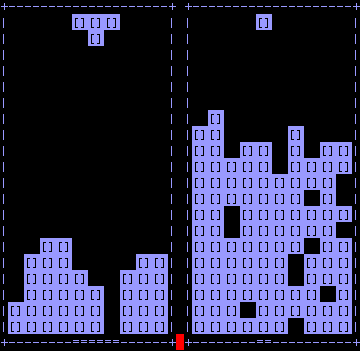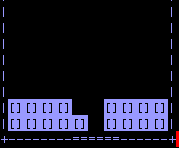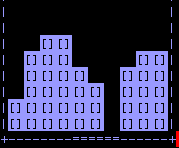netris manifesto


"It is high time that netris-players should openly, in the face of the whole world, publish their views, their aims, their tendencies, and meet this nursery tale of the spectre of netris with a manifesto of the game itself."
first of all, prospective players need an account at sdf.lonestar.org. telnet to ol.freeshell.org and follow the account creation instructions. then, i'd recommend logging out, and connecting with SSH to tty.freeshell.org. once you're inside, type 'com' to enter the chatrooms. to invite another user to play netris, type 'n user@server.' a list of users in a room along with their particular servers (user@server) is displayed when you type 'w.' to accept an invitation, the invitee simply hits 'n' once s/he sees ‹user1@machine invites user2@machine to play netris›.
invitation isn't without pitfalls, and problems can result if two users invite each other at roughly the same time. for this reason, and to avoid being stuck in a blank screen limbo waiting for the game to start, it's good to establish that someone actually wants to play before one invites them, and to clarify who will do the inviting and who will do the accepting. if there are three users interested in playing, then the third player might play the winner. however, a rivalry between two players sometimes supersedes this courtesy, and two will just keep playing each other while ignoring the third. with four interested players, no one follows any algorithms for who-plays-who. sometimes, the four will pair off, or just a random netris orgy will ensue. in a series of games, generally the loser (or challenger) carries the burden of invitation.
netris primarily taxes visual processing speed (how quickly one can rotate shapes in one's head and build receptacles based on the likelihood of a matching shape dropping next), which probably would make it ideal cognitive therapy for brain injury sufferers. it would be interesting if ability in netris correlated to ability in other areas, such as programming, mathematics, driving, drawing, etc, or if it corelated to traits such as orderliness, or something weird like depression or homosexuality (a study waiting to happen). however, it's possible that netris is an island unto itself.
each player's netris board is 10 blocks wide, and 20 blocks high. ‹j› moves a piece one block to the left, ‹k› rotates a piece clockwise, ‹l› moves a piece one block to the right, and ‹space› drops a piece all the way down. each player can pause with ‹p›, and only the player who initiated the pause can un-pause by hitting the same key. pieces can be nudged one over to the right or left immediately after dropping. more than two rows cleared appear on your opponent's board -- this is what makes the strategy in netris, which is to vanquish your opponent, different from that of tetris, which is merely to stay alive as long as possible.
good netris play has three principle sources: playing quickly, playing flat, building 'likely shapes,' and undermining your opponent. there's also a significant amount of luck involved, in the randomness of appearing pieces (statistically a 1/7 chance that a given piece will appear, although netris is subject to the same problems with random number generation as any digital system).
obviously, a player who builds more quickly will be at an advantage, as opportunities for multiple row-clearings (and their deposit on one's opponent's board) will therefore come more quickly. familiarity with the seven possible pieces and their various rotations makes quick play easier. also, on the very bottom of the board is a single-pixel line that indicates a piece's horizontal position, which is helpful to avoiding placement errors.
it's also important to play flat. by this, i mean literally making the upper surface of the bottom mass of blocks as level as possible, leaving one (or occasionally two) holes intended for a 2-4 row clearing opportunity. if one 'plays flat,' then when one's opponent clears 2-4 rows and they are transferred, in their state before they were cleared, to one's own board, then recovering from this onslaught becomes a more trivial thing. for example, if your opponent clears 4 rows at once by filling in a hole with an I-shaped piece, then those rows, *including the original hole*, will be deposited underneath your current bottom block-structure. if you are 'playing flat,' then clearing the opening to this existing hole is much easier, and you can then turn the tables on your opponent quickly.
building 'likely shapes' is more or less the same thing as playing flat, but takes the theory in terms of individual instances of structure-building, rather than a holistic approach. for instance, there are two pieces that will fit this recess, thus it's helpful to build it:

conversely, it's unhelpful to build recesses that are statistically unlikely to be met with fitting pieces. this shape relies on two I-shaped pieces to fill both holes, and is therefore generally undesirable, especially with a large deposit of bottom blocks (having a height of about half the screen):

undermining your opponent involves setting up shapes that will cause a descending piece to clear multiple rows when it fits into the structure of bottom blocks. this is crucial -- in most cases, playing purely defensively (ie, just trying to keep your bottom block structure as small as possible) will result in a loss. in this way, netris rears its competitive, aggressive head. so, more often than in tetris, netris players will shape their boards to contain long holes, waiting for L-shaped or I-shaped pieces to appear, fill the holes, immediately clear 2-4 rows, and thus make life difficult for their opponent. of course, this waiting game rapidly becomes dangerous, and is a matter of risk-management and cost-benefit: if that long piece never comes, then two towers are gradually built on either side of the waiting pit, a situation from which recovery can be nigh impossible.
on the subject of undermining, i find that a good rule of thumb is to avoid clearing single rows, but rather to try and eliminate 2 or more every time. inevitably, chance will allow the opportunity to clear 3 or 4 rows on occasion. of course, sometimes it's impossible to avoid clearing only one, when the base structure simply doesn't allow for any alternatives. however, clearing single rows as quickly as possible is an effective defensive strategy if the bottom structure gets to be alarmingly high.
it's also worth mentioning that each player gets the same sequence of pieces, and that if one's opponent is playing faster, then it's helpful to keep an eye on his or her board to get an idea of what might be coming up.
finally, the phenomenon of machine lag is an inevitability of netris. lag might come from SDF machines being overburdened, an ISP being overburdened, or one's own connection being overburdened. since lag is almost universal to some degree (especially when play is spread over many games), it makes sense to consider lag part of the game. as kendal points out, 'you should be playing well enough so that lag shouldn't be a problem.'

this is the ranking system (on 22 apr 04), viewable in SDF com by typing 'N scores.'
i take some issue with the scoring algorithm. for instance, according to the ranking, i am the third best player, which is simply not the case. in fact, as is indicated by my win:loss ratio, i'm about average.
as it is, players are ranked in terms of their total number of wins, regardless of losses or the ranking of the players they've beaten.
so a player who is less skilled than another can manage a higher rank by electing only to play less skilled opponents, or simply by playing a large number of games.
a ratio of wins/losses wouldn't work too well because, as kendal pointed out, if someone played only one game and won it, s/he could retire at #1.
i'd propose something like limiting the list to players who have played 50 or more games, then ranking in terms of wins:losses, but weighting wins over more highly-ranked players.
there is also a function to view one's 'greatest rival' (the player who has holds the most victories over one) and the record, which is the longest game. this is actually a really nice feature, since it introduces a socialist, noncompetitive element to netris play: if two players are very skillful, then they can extend a game to 200, 300, or even 700 seconds. however, this feature is undermined by the fact that games paused by either player continue to run the clock. so, as often occurs, if a player is at work and needs to pause to hide from the boss, perhaps for several minutes, then these minutes get added on to the game. i'm not sure how easy this issue would be to solve, since it would involve coding both at sdf and in the netris program.